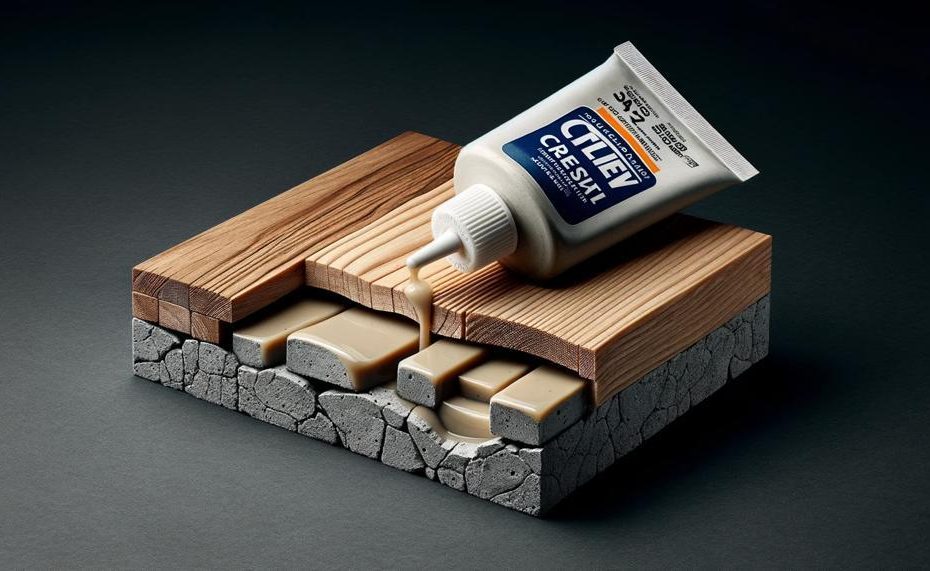Welcome to our most recent investigation, where we dig into the intriguing realm of combining concrete and solid wood, two materials that at first glance appear incompatible.
This is not your average do-it-yourself manual; rather, it’s a voyage into the world of possibilities that arise when you comprehend the technique and principles involved in successfully joining various materials.
This article is your key to success whether you’re starting a home remodeling project, making custom furniture, or you’re simply interested in material fusion.
So, can I glue solid wood to concrete?
Yes, you can glue solid wood to concrete, but you should use a flexible flooring adhesive that allows the wood to expand and contract naturally. You can use a trowel adhesive on the floor and use tape to hold the boards in place until the next day. For solid wood floors under 150 mm wide, you can use Sika MS Flexible Wood Flooring Adhesive Tub. For solid wood floors over 150 mm wide, you can use Sika T54 Flexible Wood Flooring Adhesive, which is a stronger glue.
So, let’s dive in.
Table of Contents
- 1 Characteristics of Wood and Concrete
- 2 Types of Adhesives for Bonding Wood to Concrete
- 3 Benefits of Using Epoxy Adhesive
- 4 Pros and Cons of Polyurethane Adhesive
- 5 Considerations for Construction Adhesive
- 6 Preparing the Surface for Glue Application
- 7 Applying the Adhesive Properly
- 8 Clamping or Applying Pressure During Curing Process
- 9 Conclusion
Characteristics of Wood and Concrete
Wood and concrete, each distinct in their essence, bring forth a unique set of characteristics that pose challenges and considerations when attempting to bond them through glue. Their inherent properties dictate the approach and materials required for effective adhesion.
Properties of Wood
- Porous Nature: Wood, being a natural material, exhibits a porous structure. This feature, while advantageous for certain applications, complicates the gluing process as adhesives might not penetrate evenly, affecting bond strength.
- Tensile Strength: Superior tensile strength characterizes wood, allowing it to resist stretching and tension effectively. This quality, though beneficial structurally, has minimal impact on the gluing process.
- Environmental Responsiveness: Wood responds dynamically to environmental changes. Moisture and temperature variations can lead to expansion or contraction, potentially compromising the integrity of glued joints.
Properties of Concrete
- Density and Non-porosity: Concrete, a composite material, is dense and relatively non-porous compared to wood. This lack of porosity presents a challenge for adhesion, as traditional wood glues struggle to adhere to smooth, non-porous surfaces.
- Rough Surface Texture: While concrete’s density poses one challenge, its often rough and uneven surface can further complicate adhesion. These irregularities require filling to achieve a smooth bonding surface.
- Moisture Content: Concrete’s moisture can adversely affect the curing of adhesives. Ensuring concrete is dry before application is crucial for successful bonding.
Given these differences, gluing wood to concrete necessitates a tailored approach, focusing on adhesives that can bridge these distinct characteristics. Polyurethane construction adhesive emerges as a fitting choice due to its versatility, capacity to expand into porous surfaces, and strength in bonding diverse materials.
Comparative Table
| Characteristic | Wood | Concrete |
| Porosity | Porous | Non-porous/Dense |
| Surface Texture | Generally smoother, can be sanded | Rough, uneven, may require filling |
| Response to Environment | Expands/contracts with moisture and temperature | Moisture presence affects adhesive curing |
Types of Adhesives for Bonding Wood to Concrete
Choosing the right adhesive to bond wood to concrete is crucial for a strong and lasting bond. Here’s a breakdown of the suitable types of adhesives for this purpose:
| Type of Adhesive | Properties | Applications |
| Polyurethane Adhesives | Strong and durable, withstands heavy loads and extreme temperatures, but has a longer curing time. | Ideal for projects requiring a robust bond; requires 24 hours to fully cure. |
| Epoxy Adhesives | High strength, resistant to chemicals and moisture, fast curing time but more expensive. | Suitable for projects where a quick, strong bond is necessary; cures within 5-10 minutes. |
| Construction Adhesives | High bonding strength, designed for construction, but may have low moisture resistance. | Good for a variety of construction projects, but not the best for high moisture areas. |
| Polyvinyl Acetate (PVA) Adhesives | Strong bond between wood surfaces, but not water-resistant. | Best for indoor projects where moisture is not a concern; not ideal for wood to concrete bonding. |
| Contact Adhesives | Requires pressure for bonding, can be tricky to apply evenly, may show lines on the surface. | Useful for surfaces like laminate but not the top choice for wood to concrete bonding. |
| Cyanoacrylate Adhesives | Quick bonding, strong but becomes brittle under heavy loads. | Not recommended for wood to concrete due to brittleness under stress. |
When selecting an adhesive for bonding wood to concrete, consider the specific requirements of your project, such as load-bearing capacity, exposure to moisture, and the need for a quick or slow curing time.
Benefits of Using Epoxy Adhesive
Epoxy adhesive stands out as a champion for bonding solid wood to concrete, owing to its remarkable set of attributes. This adhesive not only ensures a steadfast bond but also braves the elements and temperature swings, showcasing its versatility across various projects. Let’s dive into the specifics that make epoxy adhesive a go-to choice for such tasks:
| Feature | Advantage | Impact on Wood-to-Concrete Bonding |
| Exceptional Bonding Strength | Creates a robust, durable bond. | Ensures the wood stays securely affixed to the concrete, ideal for structural and non-structural applications. |
| Moisture and Chemical Resistance | Offers protection against damage from moisture and certain chemicals. | Makes it a solid choice for outdoor projects or in areas with high humidity, extending the lifespan of the bonded materials. |
| Versatility | Suitable for various applications beyond wood to concrete bonding. | Can be used in a myriad of projects, ensuring utility across your DIY and professional endeavors. |
| Gap-filling Properties | Can fill gaps or voids in the concrete surface, enhancing bond strength. | Leads to a smoother, more reliable bond, especially in cases where the concrete surface is uneven. |
| Long Working Time | Gives ample time to correctly position the wood before setting. | Particularly useful for complex or large-scale projects where precision is key. |
| Durability and Temperature Resistance | Can withstand extreme temperatures without losing integrity. | Ensures the bond remains strong and intact through seasonal changes, both indoors and out. |
Pros and Cons of Polyurethane Adhesive

When it comes to attaching solid wood to concrete, polyurethane adhesive steps up as a mighty contender, but like any champ, it’s got its strengths and weaknesses.
| Benefits | Drawbacks |
|
|
Considerations for Construction Adhesive
When bonding solid wood to concrete, selecting the right construction adhesive isn’t just smart; it’s essential.
The adhesive must form a steadfast bond that can weather the elements and the test of time. Here’s a breakdown of the pivotal considerations:
Material Compatibility:
Concrete’s coarse and porous nature contrasts with wood’s smoother, absorbent surface. The chosen glue must intimately acquaint itself with both, ensuring a bond that’s not just skin-deep but robust and enduring.
Bonding Strength:
Strength isn’t just muscle; it’s the heart of a good adhesive. It must grip the wood and concrete with a tenacity that laughs in the face of strain and stress.
Curing Time:
Time waits for no adhesive. A swift-setter ensures the bond locks in before any mischief from movement or weight comes into play.
Dawdlers in the curing department might leave you with a bond that’s more of a handshake than an embrace.
Environmental Resilience:
The elements play no favorites. Be it the caress of moisture or the temper of temperature swings, your adhesive must stand unflinching, ensuring the bond remains unbroken.
Material Specifics:
Not all woods and concretes are born equal. Their varied porosity and strength mean some adhesives play favorites.
A trial tango with different glues might just reveal the perfect match.
| Factor | Why It Matters | What to Look For |
| Material Compatibility | Ensures adhesive bonds well with both wood and concrete’s distinct surfaces. | Adhesives labeled for multi-surface or specifically for wood-to-concrete applications. |
| Bonding Strength | A strong bond withstands stress and load without faltering. | High-strength adhesives, often indicated by PSI rating. |
| Curing Time | A quicker cure time reduces the risk of bond failure due to movement. | Adhesives with rapid set times, usually specified on the product. |
| Environmental Resilience | Ensures the bond holds up under varying conditions like moisture and temperature changes. | Waterproof or all-weather adhesives. |
| Material Specifics | Different woods and concretes may interact uniquely with adhesives. | Testing adhesives on your specific materials before full application. |
Preparing the Surface for Glue Application
To properly prepare the surface of concrete for gluing solid wood, follow these meticulously outlined steps to ensure a robust and enduring bond.
Each action is pivotal, aiming to foster an optimal surface for adhesive application.
| Step | Action | Details |
|---|---|---|
| 1 | Clean the Concrete Surface | Remove all dirt, dust, and debris with a broom, vacuum, or pressure washer. This step is critical for a clean bonding surface. |
| 2 | Inspect and Repair Concrete | Check for cracks or uneven areas. Use a suitable patching compound for repairs, ensuring the surface is level and smooth. |
| 3 | Roughen the Wood Surface | Lightly sand the wood surface to create a texture that the adhesive can grip. This promotes better adhesion. |
| 4 | Clean the Wood Surface | After sanding, remove any sawdust or debris to prevent interference with the glue’s adhesion. |
| 5 | Apply Primer or Sealer (Optional) | Consider treating the wood with a primer or sealer to reduce moisture absorption, enhancing durability. |
| 6 | Choose the Right Adhesive | Select an adhesive specifically designed for bonding wood to concrete. Confirm it suits your project’s needs. |
| 7 | Apply Adhesive According to Instructions | Follow the manufacturer’s guidelines for adhesive application to ensure optimal performance. |
| 8 | Position and Press Wood onto Concrete | Align the wood precisely and press firmly onto the concrete. Use clamps or weights to maintain contact while the adhesive cures. |
| 9 | Allow Adhesive to Cure | Give the adhesive ample time to set, based on the manufacturer’s recommendations, before loading or stressing the bond. |
This process, rooted in attentiveness and precision, guarantees a bond that’s not just strong but lasting. Whether it’s ensuring the concrete and wood surfaces are impeccably clean and ready for adhesion, or carefully selecting and applying the adhesive, each step is a link in a chain of durability. So, roll up your sleeves and give these surfaces the thorough, keen-eyed preparation they demand.
Applying the Adhesive Properly
The process of adhering solid wood to concrete hinges on meticulous surface preparation and correct adhesive application. The steps to ensure a robust bond are as follows:
| Step | Action | Details |
| Measurement and Marking | Mark the area | Ensures accurate adhesive application |
| Surface Preparation | Clean and dry surfaces | Crucial for adhesive bonding |
| Applying Adhesive | Apply in zig-zag pattern | Use a suitable construction adhesive |
| Wood Placement | Align and place wood | Ensure even contact with adhesive |
| Securing the Bond | Use clamps/weights | Hold until adhesive cures |
| Optional Reinforcement | Use screws | For extra stability |
Clamping or Applying Pressure During Curing Process
When gluing solid wood to concrete, clamping or applying pressure is a pivotal step in the curing process.
| Benefit | Explanation | Impact |
| Full Contact | Ensures complete surface bonding | Maximizes bond effectiveness |
| Gap Elimination | Removes air pockets | Increases bond uniformity |
| Adhesive Control | Removes excess glue | Neater finish, stronger bond |
| Strength and Durability | Essential for construction/furniture | Long-lasting bond |
| Method Variation | Tailored pressure application | Ensures even distribution |
| Preparation | Surface and adhesive readiness | Foundation for successful bonding |
Conclusion
We explore the area where concrete and wood collide, revealing the complexities involved in joining these two unlike materials. It takes careful coordination between science and skill to successfully combine solid wood and concrete; it’s not just a matter of putting glue on and hoping for the best.
It becomes clear from this experience that selecting the proper wood and concrete combination is essential. We emphasize the significance of comprehending the distinct qualities of the materials by walking you through the process of creating a long-lasting connection without any hassles.
Concrete is solid and nonporous, while wood, with its porous nature and environmental reactivity, is a difficulty. Polyurethane and epoxy adhesives, on the other hand, are two options for overcoming this difficulty because of their respective advantages in bridging the material gap. The story doesn’t end with choosing; it also highlights the skill of application and preparation, making sure surfaces are ready for an unwavering connection. The possibilities of fusing wood and concrete are endless, ranging from creative applications to troubleshooting hints.
We feel motivated to change the commonplace as we draw to a close our investigation. Equipped with an understanding and inventiveness, the combination of wood and concrete is proof of inventiveness when confronted with apparently incompatible components.






